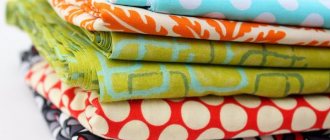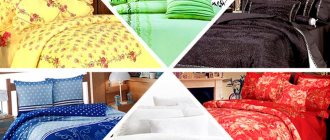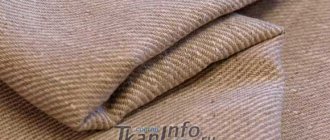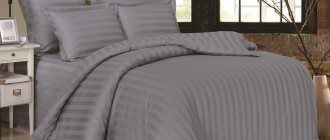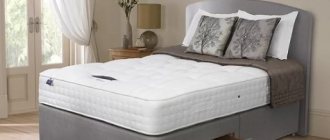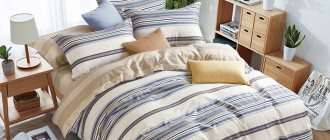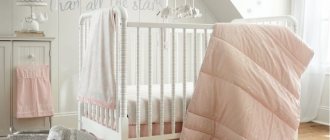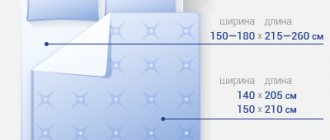Making your own bedding is the best way to get sleep accessories in the right colors and the perfect size. To successfully cope with this task, you do not need to be a professional seamstress - just carefully study the instructions and strictly adhere to them. And the first thing you need to start with is to calculate the fabric for a set of bed linen without errors, so that there is enough linen and there are no extra pieces left. And this is not difficult to do if you know exactly what size pillows, mattress and blanket you need to “dress”.
Do I need to consider the type of fabric?
To make a perfect set of sleeping accessories, it is not enough to make the pattern correctly and carefully sew the seams. The result of the efforts largely depends on what material was chosen. When calculating how much fabric you need to buy for a set of bed linen, it is important to take into account its main characteristics:
- Naturalness . Synthetics are the worst things you can buy for sleep accessories. Preference should be given to natural materials that absorb moisture well, allow air to pass through in the summer and retain heat in the winter. Bedding made from synthetic fibers does not allow the skin to breathe freely at night, which means that sweat does not evaporate from its surface, causing diaper rash and allergic reactions. As a last resort, you can buy a material with a mixed composition of cotton and polyester, but the latter should be no more than 30% so that the quality of the fabric does not suffer. Some housewives prefer just this combination - bedding sets made from different types of fibers are easier to iron and do not shrink after washing.
- Comfort . A person comes into contact with sleeping accessories for 7-8 hours in a row, so it is important that they are soft and pleasant to the touch. Hard and rough materials prevent you from falling asleep quickly and deeply, creating constant discomfort, so do not underestimate the importance of tactile sensations.
- Wear resistance . Bed linen must be washed frequently, so the material should not deteriorate from contact with hot water and detergents. The type of weaving of the threads also matters - it determines how quickly the dirt will be washed off.
Fabrics for sewing bed linen must be of high quality, otherwise they will quickly become unusable from daily use and frequent washing.
For these purposes, mainly cotton fabrics are used:
- Chintz . It is distinguished by a variety of patterns and colors, it is lightweight, and upon contact it leaves a pleasant sensation on the skin. But it is quite thin, so it is not designed for many years of service.
- Satin . Strong, durable, but at the same time soft and lightweight material. Bed sheets made from satin remain beautiful even after numerous washes, so they are more expensive than those made from chintz or calico.
- Flannel . Eco-friendly and hypoallergenic material that does not lose strength and softness even after frequent washing. It is favorably distinguished by its high hygroscopicity, ease of maintenance and affordable price.
- Calico . Dense, wear-resistant fabric with a wide variety of colors that do not lose their brightness even over the years. Over time, bedding made from calico becomes softer, but its quality does not suffer from this.
Much less often, bedding is made from pure linen. It is more rigid in nature, but at the same time it has good thermoregulation: it is cool to sleep under it in the summer heat and warm and cozy in winter. In order not to lose these valuable qualities, manufacturers of sleep accessories use linen fabric mixed with cotton fibers as raw materials, but such fabric is more expensive than the usual calico and satin. Cotton also goes well with bamboo in a ratio of 40 to 60%. This material produces breathable bedding, soft, absorbs moisture well and has antibacterial properties.
For children's bedding, choose natural fabrics.
Particular attention is paid to the quality of the material when sewing bedding for cribs. A child’s sensitive skin should not come into contact with rough or artificial material, which means that for bedding you need to find fabric with an absolutely natural composition, dense, but not hard. Also important is its hygroscopicity, ability to pass air and durability - children's bedding will have to be washed often, so it should not lose its appearance from water and high temperature.
Cotton materials cope best with these tasks: calico, satin, ranfors and flannel. They do not accumulate static electricity, are environmentally friendly, absorb moisture well and do not cause irritation to the delicate skin of infants.
How to sew bed linen with your own hands: step-by-step instructions
Cut out the fabric using the diagram you drew, like a sketch. Double-check yourself carefully and only then cut along the intended lines. You should have three pieces: a sheet, a duvet cover and a pillowcase. Step-by-step instructions will help you understand how to sew bed linen.
sheet
- If the edge of the sheet looks aesthetically pleasing, then leave it without a hem.
- Fold the open cut by 2.5 cm, fold it again so that the edge is hidden inside.
- Baste the hem by hand to prevent it from unraveling.
- Machine stitch along this basting.
- Process the opposite, open section of the sheet in the same way.
Duvet cover
- Double fold all sides.
- Fold the fabric in half along the fold line, right side inward.
- Secure with pins or basting to prevent the material from slipping or shifting.
- Sew all sides (except the fold), leaving an opening of approximately 20-25 cm for the blanket.
- Be sure to make fastenings near the hole so that the stitching does not unravel in the future.
Pillowcase
- Initially, finish the open sections with a double hem.
- Now fold the pillowcase face inward, with the flap on top.
- Baste and then double-stitch the side seams.
- Turn the pillowcase inside out and iron it.
Video on the topic
In order to sew bed linen correctly and not make mistakes with the sizes, experienced craftswomen recommend initially washing new fabric. It will give the initial, most noticeable shrinkage. This is especially true for chintz.
Calculation of fabric for a single bed set
Ready-made bedding for single beds is now quite rare in stores. Therefore, many people have to buy one-and-a-half sheets and duvet covers instead, which are not very convenient to use on narrow mattresses. How many meters of fabric will it take to sew a set of bed linen for a single bed yourself?
The standard size of a duvet cover in such a set is 200 by 150 cm, sheets - 220 by 150, pillowcases - 60 by 60 cm. If the width of the fabric is 220 cm, the calculation is as follows: 300 cm per duvet cover (with a fold in the middle) + 150 cm per sheet + 60 cm for pillowcase = 510 cm. Thanks to the large width of the fabric from a cut 60 cm long, you can easily cut a cover for a pillow with a smell by measuring a piece of fabric 140 x 60. To the resulting value you need to add 10 cm for seams and shrinkage during the first wash. Thus, for a single set you will need 5.2 m of material.
Cut out one and a half sets of bed linen.
If the width of the fabric is 150 cm, a cut of 400 cm long (with a fold in the middle) will be needed for the duvet cover, 220 cm for the sheet, and 60 cm for the pillowcase with a flap. This means that, taking into account the standard increase for seams and shrinkage, you will have to buy 6.9 m of fabric.
Classification
The classification of bed linen by size in Russia and in Europe differs not only in numbers: European linen is marked with symbols in English.
Single bed linen can be designated as “1-bed” or “single”.
Double – “2-bed”, “full” or “double”.
"Queen" is the equivalent of the Russian "Euro". One-and-a-half sets are designated as “1.5-bed” and “extra-long single”.
You can also sometimes find “king-size” sets, which are essentially “three-bedroom”.
The designation “baby bed” is typical for linen for the cribs of small children and newborns.
Calculation of fabric for a one-and-a-half-bed set
To sew a set of bedding for a single bed that is ideal in size, you need to know the exact measurements of the components included in it. In this case, the following are considered standard:
- sheet 220 x 150 cm (1 piece);
- duvet cover 215 x 145 cm (1 piece);
- pillowcase 70 x 70 or 50 x 70 cm (2 pcs.).
For fabric 220 cm wide, taking into account seam allowances and shrinkage, the calculation is made as follows:
- For pillows 70 by 70 cm. 153 cm (sheet) + 293 cm (duvet cover) + 163 cm (2 covers with flap) + 5% shrinkage = 640 cm.
- For pillows 50 by 70 cm. 153 cm (sheet) + 293 cm (duvet cover) + 123 cm (2 covers with flap) + 5% shrinkage = 600 cm.
Sew a pillow
For pillows you need a piece of 210x150 divided in half (i.e. 2 times 105x75 cm).
The cutting pattern for bed linen (width 220) for 50x70 pillows is as follows. Width 70 cm + 70 cm + 5 cm (for allowance) + 20 cm (for allowance), length 50 cm + 50 cm + 5 cm for allowance.
We retreat 2 cm on the long side, hem it with a decorative stitch, then retreat 70 cm, bend it, and sew it on the sides from the wrong side with a double seam. Then we make a 20 cm bend again and simply process the edges on all sides. The result is a pillowcase with a bend.
After the bed linen is sewn, it must be washed again in soapy water and ironed on both sides.
Calculation of fabric for a double set
Modern manufacturing companies offer customers a wide selection of ready-made bedding sets for double beds. But many housewives prefer to cut and sew their own sleeping accessories in order to fit them exactly to the size of mattresses, pillows and blankets. Knowing their length and width, you can easily make calculations and buy exactly as much material as you need for the job.
The bedding set for a double bed includes:
- sheet 220 x 180 cm (1 piece);
- duvet cover 215 x 175 cm (1 piece);
- pillowcase 70 x 70 or 50 x 70 cm (2 pcs.).
Fabric consumption for a double set with a width of 220 cm is calculated using a simple formula:
- For pillows 70 by 70 cm. 183 cm (sheet) + 353 cm (duvet cover) + 163 cm (2 wrap covers) + 5% shrinkage = 735 cm.
- For pillows 50 by 70 cm. 183 cm (sheet) + 353 cm (duvet cover) + 123 cm (2 wrap covers) + 5% shrinkage = 700 cm.
Despite generally accepted standards, on store shelves there are bedding sets labeled “double”, differing in the sizes of sheets and duvet covers. Acceptable options for the former are 210 by 175, 220 by 215 and 230 by 210 cm, for the latter - 210 by 180 and 220 by 200 cm. However, with a fabric width of 220 cm, the required amount of material is calculated using a similar formula.
When buying a linen for a set of bed linen, you need to focus not only on the calculations made, but also on the color of the material and the picture shown.
If it is plain or decorated with small ornaments, there will be no problems, but with large images and plot pictures the situation is different. In order not to spoil the appearance of the product, it is not recommended to cut them into pieces, so it is better to buy such material with a small margin, simplifying your task during cutting.
How to calculate material for Euro sizes
Standard sets of European sizes include:
- sheet 240 x 220 cm;
- duvet cover 220 x 200 cm;
- 2 pillowcases 70 x 70 cm;
- 2 pillowcases 50 x 70 cm.
Their distinctive feature is the presence of covers not for 2, but for 4 different-sized pillows, so the “<euro” sets are considered more convenient and versatile.
The required amount of material with a width of 220 cm in this case is calculated by the formula: 243 cm (sheet) + 403 cm (duvet cover) + 163 cm (2 covers 70 by 70 with wrap) + 123 cm (2 covers 50 by 70 with wrap) + 5% shrinkage = 980 cm.
For different manufacturing companies, the length and width of the components of ready-made euro sets may differ by 10-15 cm. Therefore, when purchasing, you need to carefully study the information on the label or do the sewing yourself.
Calculation of matter for a family set
How much material do you need for a family bedding set? Based on the table of standard sizes, this kit includes:
- sheet 240 by 220 cm;
- duvet cover 215 by 145 (2 pcs.);
- pillowcase 70 by 70 (2 pcs.).
The calculations in this case are as follows: 243 cm (sheet) + 586 cm (2 duvet covers) + 163 cm (2 wrap covers) + 5% shrinkage = 10 m 45 cm.
Ready-made family bedding sets are designed for pillows 70 x 70 cm, but they can also be equipped with covers of smaller dimensions.
